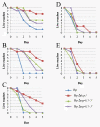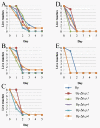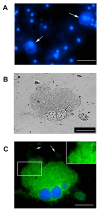The Madagascar hissing cockroach as a novel surrogate host for Burkholderia pseudomallei, B. mallei and B. thailandensis
- PMID: 22892068
- PMCID: PMC3431275
- DOI: 10.1186/1471-2180-12-117
The Madagascar hissing cockroach as a novel surrogate host for Burkholderia pseudomallei, B. mallei and B. thailandensis
Abstract
Background: Burkholderia pseudomallei and Burkholderia mallei are gram-negative pathogens responsible for the diseases melioidosis and glanders, respectively. Both species cause disease in humans and animals and have been designated as category B select agents by the Centers for Disease Control and Prevention (CDC). Burkholderia thailandensis is a closely related bacterium that is generally considered avirulent for humans. While it can cause disease in rodents, the B. thailandensis 50% lethal dose (LD50) is typically ≥ 104-fold higher than the B. pseudomallei and B. mallei LD50 in mammalian models of infection. Here we describe an alternative to mammalian hosts in the study of virulence and host-pathogen interactions of these Burkholderia species.
Results: Madagascar hissing cockroaches (MH cockroaches) possess a number of qualities that make them desirable for use as a surrogate host, including ease of breeding, ease of handling, a competent innate immune system, and the ability to survive at 37°C. MH cockroaches were highly susceptible to infection with B. pseudomallei, B. mallei and B. thailandensis and the LD50 was <10 colony-forming units (cfu) for all three species. In comparison, the LD50 for Escherichia coli in MH cockroaches was >105 cfu. B. pseudomallei, B. mallei, and B. thailandensis cluster 1 type VI secretion system (T6SS-1) mutants were all attenuated in MH cockroaches, which is consistent with previous virulence studies conducted in rodents. B. pseudomallei mutants deficient in the other five T6SS gene clusters, T6SS-2 through T6SS-6, were virulent in both MH cockroaches and hamsters. Hemocytes obtained from MH cockroaches infected with B. pseudomallei harbored numerous intracellular bacteria, suggesting that this facultative intracellular pathogen can survive and replicate inside of MH cockroach phagocytic cells. The hemolymph extracted from these MH cockroaches also contained multinuclear giant cells (MNGCs) with intracellular B. pseudomallei, which indicates that infected hemocytes can fuse while flowing through the insect's open circulatory system in vivo.
Conclusions: The results demonstrate that MH cockroaches are an attractive alternative to mammals to study host-pathogen interactions and may allow the identification of new Burkholderia virulence determinants. The importance of T6SS-1 as a virulence factor in MH cockroaches and rodents suggests that the primary role of this secretion system is to target evasion of the innate immune system.
Figures





Similar articles
-
The Madagascar Hissing Cockroach as an Alternative Non-mammalian Animal Model to Investigate Virulence, Pathogenesis, and Drug Efficacy.J Vis Exp. 2017 Nov 24;(129):56491. doi: 10.3791/56491. J Vis Exp. 2017. PMID: 29286449 Free PMC article.
-
Burkholderia pseudomallei JW270 Is Lethal in the Madagascar Hissing Cockroach Infection Model and Can Be Utilized at Biosafety Level 2 to Identify Putative Virulence Factors.Infect Immun. 2022 Aug 18;90(8):e0015922. doi: 10.1128/iai.00159-22. Epub 2022 Jul 11. Infect Immun. 2022. PMID: 35862734 Free PMC article.
-
pH Alkalinization by Chloroquine Suppresses Pathogenic Burkholderia Type 6 Secretion System 1 and Multinucleated Giant Cells.Infect Immun. 2016 Dec 29;85(1):e00586-16. doi: 10.1128/IAI.00586-16. Print 2017 Jan. Infect Immun. 2016. PMID: 27799332 Free PMC article.
-
The Burkholderia Type VI Secretion System 5: Composition, Regulation and Role in Virulence.Front Microbiol. 2019 Jan 10;9:3339. doi: 10.3389/fmicb.2018.03339. eCollection 2018. Front Microbiol. 2019. PMID: 30687298 Free PMC article. Review.
-
Molecular insights into Burkholderia pseudomallei and Burkholderia mallei pathogenesis.Annu Rev Microbiol. 2010;64:495-517. doi: 10.1146/annurev.micro.112408.134030. Annu Rev Microbiol. 2010. PMID: 20528691 Review.
Cited by
-
Marmosets as models of infectious diseases.Front Cell Infect Microbiol. 2024 Feb 23;14:1340017. doi: 10.3389/fcimb.2024.1340017. eCollection 2024. Front Cell Infect Microbiol. 2024. PMID: 38465237 Free PMC article. Review.
-
Effects of Colonization of the Roots of Domestic Rice (Oryza sativa L. cv. Amaroo) by Burkholderia pseudomallei.Appl Environ Microbiol. 2015 Jul;81(13):4368-75. doi: 10.1128/AEM.00317-15. Epub 2015 Apr 24. Appl Environ Microbiol. 2015. PMID: 25911477 Free PMC article.
-
Oropharyngeal aspiration of Burkholderia mallei and Burkholderia pseudomallei in BALB/c mice.PLoS One. 2014 Dec 11;9(12):e115066. doi: 10.1371/journal.pone.0115066. eCollection 2014. PLoS One. 2014. PMID: 25503969 Free PMC article.
-
Characterization of pathogenesis of and immune response to Burkholderia pseudomallei K96243 using both inhalational and intraperitoneal infection models in BALB/c and C57BL/6 mice.PLoS One. 2017 Feb 24;12(2):e0172627. doi: 10.1371/journal.pone.0172627. eCollection 2017. PLoS One. 2017. PMID: 28235018 Free PMC article.
-
The utilization of Blaptica dubia cockroaches as an in vivo model to test antibiotic efficacy.Sci Rep. 2021 Dec 14;11(1):24004. doi: 10.1038/s41598-021-03486-3. Sci Rep. 2021. PMID: 34907348 Free PMC article.
References
-
- Waag DM, DeShazer D. In: Biological Weapons Defense: Infectious Diseases and Counterbioterrorism. Lindler LE, Lebeda FJ, Korch GW, editor. Humana Press Inc, Totowa, New Jersey; 2004. Glanders: new insights into an old disease; pp. 209–237.
-
- Vietri NJ, DeShazer D. In: Medical Aspects of Biological Warfare. Dembek ZF, editor. Department of the Army, Office of The Surgeon General, Borden Institute, Washington, DC; 2007. Melioidosis; pp. 147–166.
-
- Brett PJ, DeShazer D, Woods DE. Burkholderia thailandensis sp. nov., description of a Burkholderia pseudomallei-like species. Int J Syst Bacteriol. 1998;48:317–320. - PubMed
-
- Galyov EE, Brett PJ, DeShazer D. Molecular insights into Burkholderia pseudomallei and Burkholderia mallei pathogenesis. Annu Rev Microbiol. 2010;64:495–517. - PubMed
Publication types
MeSH terms
Substances
LinkOut - more resources
Full Text Sources
Molecular Biology Databases

